For decades the Honda Civic has been one of the smartest choices among compacts cars. And it’s easy to see why Honda‘s smallest sedan has been the easy choice for so many buyers: refined driving manners, impressive fuel economy, sterling reliability, a low cost of entry, and high resale value. These characteristics have cultivated countless fans of the Civic and made it a benchmark for legions of rivals.
Today’s Civic is the most mature and refined yet, but its inherent objective of being an economical, easy-to-drive, reliable compact sedan remains. And while it is no longer offered as a hatchback (there’s the smaller Honda Fit for that), the 2014 Honda Civic retains its everyman role by offering a variety of other configurations and styles. A 47-mpg hybrid model improves upon the standard Civic’s already impressive fuel economy. The performance-oriented Si continues to offer inexpensive thrills. A version that runs on compressed natural gas (CNG) rather than gasoline offers lower emissions and can grant solo access to carpool lanes. And for those seeking something sportier and sleeker, 2-door coupe models are available on a variety of trims, including the Civic Si.
In a bid to keep its status as a segment leader — and quiet critics who complained of blandness — the Civic has undergone two significant updates in the two short years since its latest-generation model debuted in 2012. The 2014 Civic now brims with handsome design inside and out, including the snazzy LaneWatch blind-spot monitoring system that displays live video of the lane next to the rear right of the car, and a standard rearview camera. The new 7-inch touch-screen audio and information system that’s standard on EX models is visually appealing, but its multi-step touch process can be distracting. Also frustrating is the lack of a physical volume control on the dash — changes require a touch of the finger and decent aim. Thankfully there are redundant controls on the steering wheel.
The rest of the interior scores generally high marks with its digital speedometer, easy-to-use climate controls, and comfortable front seats with significant lumbar support. Rear-seat accommodations are rather tight, and trunk cargo capacity was just decent among our group. On the road, the Civic is comfortable, quiet and easygoing. Its 143-horsepower engine provides adequate acceleration, and a Sport mode adjusts the throttle for briskness. A highlight is the Civic’s new continuously variable automatic transmission (CVT), which largely mimics a traditional automatic and helps return fuel-economy figures of 30 mpg city/39 mpg highway in standard Civics, and up to 41 mpg in a high-mileage variant. Finally, with an as-tested price of $21,880, the Civic was the least-expensive of the models we compared, yet felt like much more car for the money.
Here’s how the 2014 Honda Civic EX fared against rivals in our compact-sedan comparison test:
Honda Civic vs. Ford Focus
The Focus has good steering feel and cornering ability, but it can’t match the Civic’s comfortable road manners. The Ford‘s automatic transmission doesn’t feel as refined as the Civic’s standout CVT. Where the Civic’s interior layout is clean and functional, the Focus has too many buttons, too much plastic and an unintuitive infotainment system.
Honda Civic vs. Kia Forte
The Forte feels sportier than the Civic thanks to a more powerful engine, a 6-speed automatic transmission that’s eager to kick down a gear or two, and a tighter suspension. On the flip side, the Civic is more comfortable and quiet, and returns better fuel economy. The Kia Forte has impressive creature comforts and a robust infotainment system that is easy to use. The Forte has a premium feel, yet the Civic still seems the more mature of the two.
Honda Civic vs. Mazda Mazda3
The Mazda3 proved to be the athlete of this group thanks to its nimble handling, peppy powertrain and eager transmission. It’s not quite as comfortable on the highway as the Civic, but it’s certainly not uncomfortable. And while the Civic’s touch-screen infotainment system is sleek, the Mazda3’s slick center screen and easy-to-use center-console rotary command module seem straight out of a premium car.
Honda Civic vs. Nissan Sentra
The Civic feels sportier and quicker on its feet than the Sentra, which is more a testament to the Nissan‘s easy-does-it approach than sheer performance from the Honda. The Sentra is the least-powerful car in this group and just doesn’t like to be pushed hard, and when it is the CVT automatic transmission drones. However, if a roomy cabin and comfortable and quiet ride take priority, the Sentra bests the Civic in these respects.
Honda Civic vs. Toyota Corolla
Surprisingly, these longtime archrivals feel more similar than different if judged on driving manners. Both are pleasing but not particularly sporty, and each has a responsive transmission and adequate acceleration. Inside, their aesthetics part ways, with the recently revamped Corolla boasting an intuitive 2-tier control panel and a high dash that created divided opinions among our editors.
Next Stop
How much should you pay for a new Honda Civic? How does its 5-Year Cost to Own stack up? If you’re interested in exploring Honda’s compact sedan further, our Honda Civic Editors’ Page is the place to start.
If you’re still weighing your options, check out the other five cars included in our 2014 Compact Sedan Comparison Test.
Popular at KBB.com
10 Best Sedans Under $25,000
10 Best SUVs Under $25,000
The 40 MPG Cars of 2014
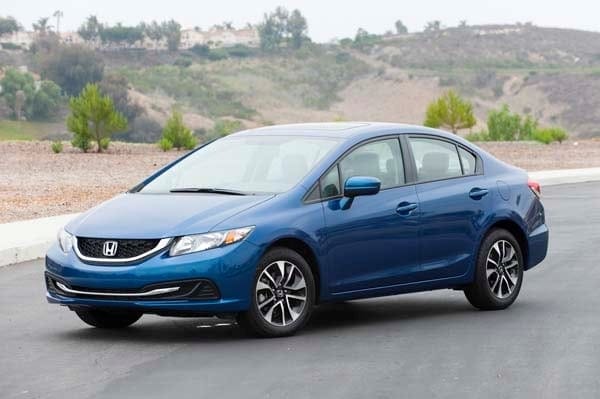
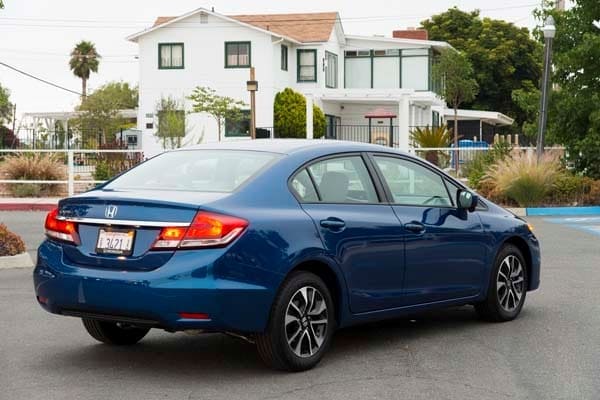
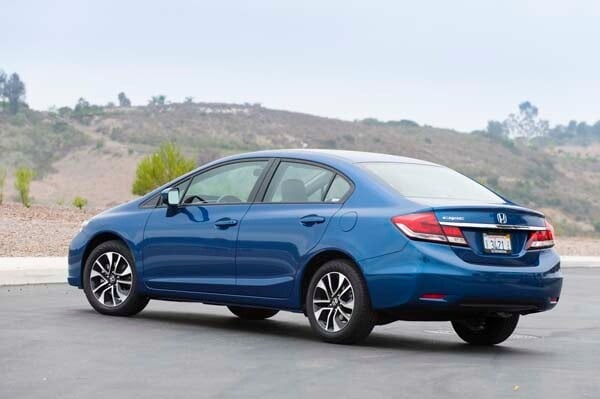
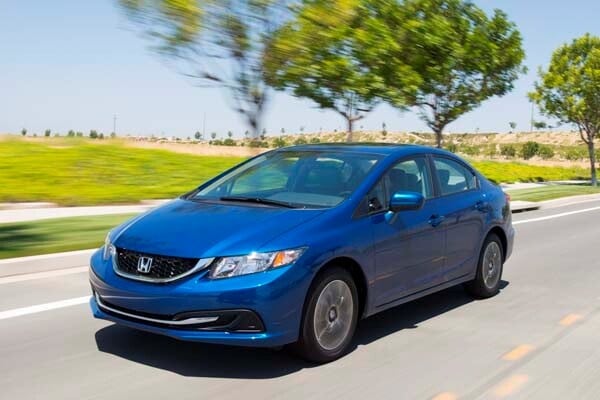
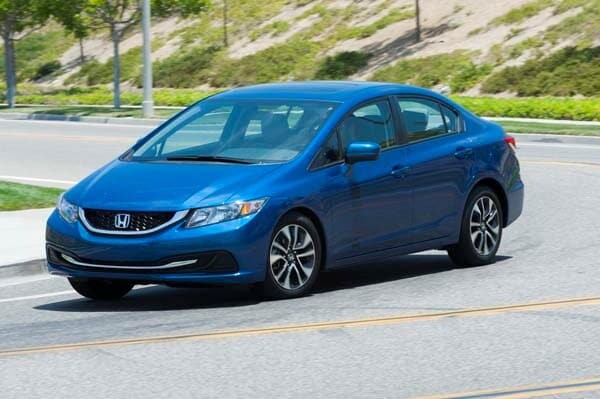
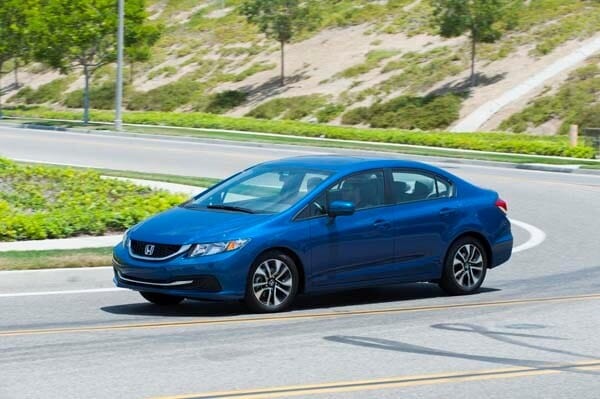
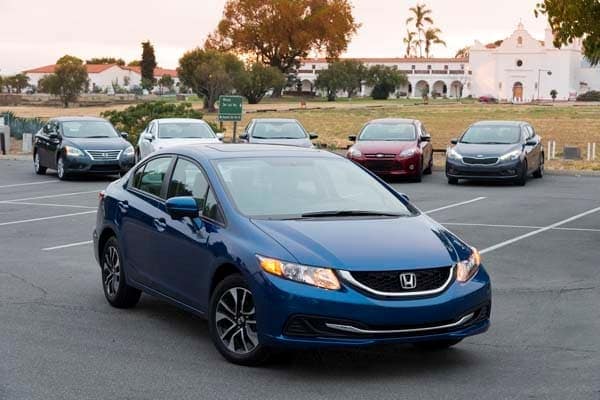

-180.jpg)








